Wild Zora Mountain Beef Stew Shelf Life
It almost goes without saying: dinnertime is one of the best parts of any backpacking trip. There's just nothing quite like warm, filling food after a long day on the trail. In choosing the best backpacking meals of 2022, we focus on taste, nutritional value, packability, preparation time, and cleanup. In addition, weight, calories, and price certainly matter to most backpackers, so we calculated handy "calories per ounce" and "calories per dollar" specs for each. For more background information on choosing the right meal, see our comparison table and buying advice below the picks. To complete your mealtime toolkit, see our article on the best backpacking stoves.
Our Team's Backpacking Meal Picks
- Best Just-Add-Water Backpacking Meals: Good To-Go
- Best Budget Backpacking Meals:Backpacker's Pantry
- Best Backpacking Meals for Foodies: Heather's Choice
- Best Calorie-Dense Backpacking Meals:Peak Refuel
- Best Marketplace for Backcountry Chefs: Harmony House Foods
Best Just-Add-Water Backpacking Meals
1. Good To-Go ($8 - $15)
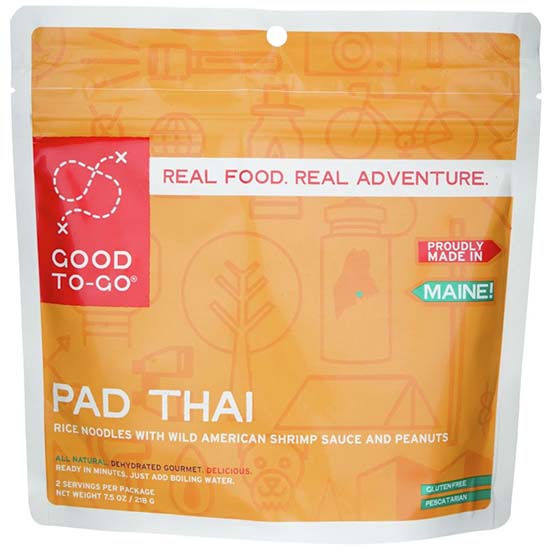 Cooking method: Pouch
Cooking method: Pouch
Average cook time: 15-20 minutes
Calories per ounce: 112
What we like: Great flavors and healthy, real ingredients.
What we don't: Expensive; slower to cook than many of the options below.
Good To-Go represents the next generation of backpacking meals: food that we actually would consider eating at home. Designed by professional chef Jennifer Scism, the assortment of all-natural, gluten-free meals have serious flavor and an ingredient list that is short and readable (translation: real food). The volume of offerings can't match some of the companies below—Good To-Go has 13 dinner options to date—but the combination of flavor, quality ingredients, and calorie-to-weight ratio earns this Maine-based company a resounding numero uno.
You'd expect Good To-Go meals to be pricey given their premium ingredients, but they fall about mid-pack in our calories per dollar metric and less than most all-natural meals here. The largest drawback is cook time: real-food ingredients slow the prep process, meaning the meals take up to 20 minutes to rehydrate (and longer at higher elevations). If you need quick calories, other pouch meals such as Mountain House, Peak Refuel, and AlpineAire cook in half the time. It's no contest for us, though: Good To-Go is worth the wait.
See Good To-Go Meals
Best Budget Backpacking Meals
2. Backpacker's Pantry ($7 - $13)
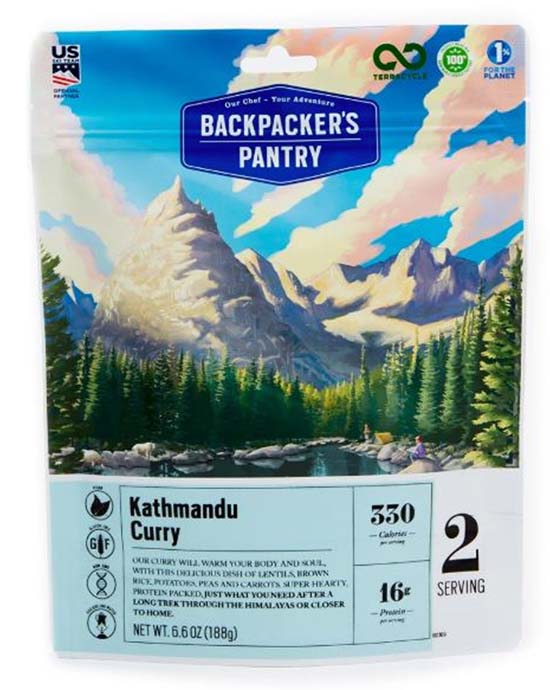 Cooking method: Pouch
Cooking method: Pouch
Average cook time: 15-20 minutes
Calories per ounce: 113
What we like: Great bang for your buck and incredible selection.
What we don't: These take a long time to cook.
Backpacker's Pantry has been making dehydrated meals for decades and still is among the most recognizable backpacking food brands. The company has one of the largest selections of backcountry meals on the market, including many gluten-free, vegan, and organic options. And they've kept up with the times, with meals for a foodie palate like Jamaican Jerk Rice with Chicken, Kathmandu Curry, and Pad Thai (which even comes with a small package of peanut butter and handful of separately packaged peanuts). Additionally, all Backpacker's Pantry meals are MSG-free and have a shelf life of 7 years (25 years for their bulk cans).
If you visit the food aisle of just about any outdoor store, you'll see Backpacker's Pantry, Mountain House, and AlpineAire compete for the title of most ubiquitous backcountry meal. All three are reasonably priced and come in flat, packable pouches, large serving sizes, and a plethora of special diet options. But we think Backpacker's Pantry meals taste better than the competition, and at 69.9 calories per dollar on average, they offer excellent bang for your buck too (Mountain House and AlpineAire meals average 54.6 and 65.8 calories per dollar, respectively). In fact, some of their two-serving meals (like Kathmandu Curry) cost as little as $6.95. You'll have to wait a bit longer to enjoy a Backpacker's Pantry meal, but the value is hard to beat.
See Backpacker's Pantry Meals
Best Backpacking Meals for Foodies
3. Heather's Choice ($13 - $16)
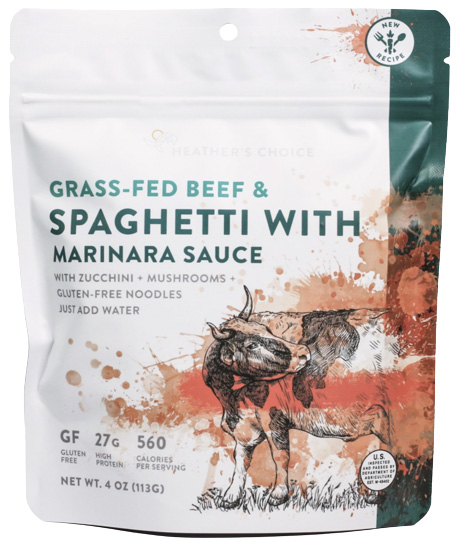 Cooking method: Pouch
Cooking method: Pouch
Average cook time: 20 minutes
Calories per ounce: 130
What we like: Ethically sourced food that tastes really good.
What we don't: Expensive; not a ton of options.
After dehydrating her own backcountry food for years, Alaska-based Heather Feather launched Heather's Choice via a Kickstarter campaign in 2015. Now, this small and growing company is one of our favorite choices when it comes to taste, ingredients, and gluten-free options. Heather takes care in putting together her meals, using high-powered foods such as coconut, maple syrup, wild-caught Alaskan Sockeye salmon, and 100-percent grass-fed bison and elk. Impressively, many of the dinner options contain a whopping 35-40 grams of protein per serving and average out to 130 calories per ounce. And the cherry on top: each meal comes in an impressively tiny package (kudos to Heather for conserving materials), which is great for small packs and spoons alike.
You don't get a ton of options with Heather's Choice, especially if you're a vegetarian (although each dinner is gluten, soy, egg, and dairy-free). Further, the one-serving meals will run you as much as $16, and at around 500 calories per entrée, you get a lot less bang for your buck than with Good To-Go above (34.4 calories per dollar vs. 53.7). But we think Heather's Choice is the best-tasting food around, and the tradeoffs could be well worth it for those who don't want to compromise enjoyment or nutrition while on the trail. And to complete your kit, we also recommend looking at Heather's Choice's breakfast options ($9) and her popular cookie-like Packaroons, which offer 170 calories of healthy fats and sugars in a 1-ounce package.
See Heather's Choice Meals
Best Calorie-Dense Backpacking Meals
4. Peak Refuel ($13)
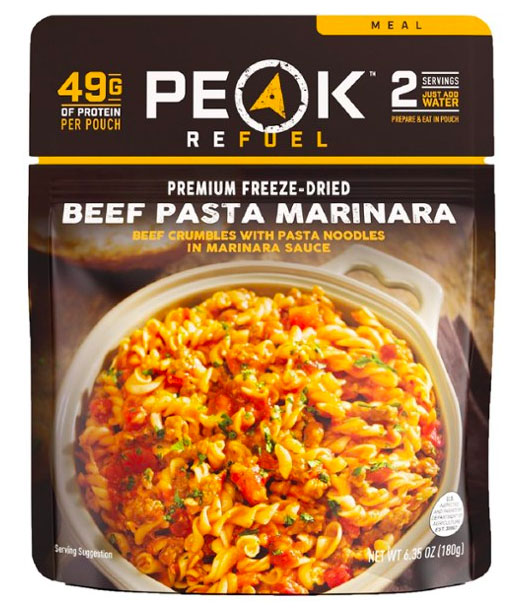 Cooking method: Pouch
Cooking method: Pouch
Average cook time: 10 minutes
Calories per ounce: 155
What we like: Packed with calories and protein.
What we don't: Dishes are noodle-heavy and only come in two-serving pouches.
Peak Refuel might be relatively new to the backpacking scene, but they've hit the ground running with a competitive lineup of high-powered meals for your next adventure. Their dinners pack a serious punch with an average of 155 calories per ounce and one of the highest protein counts of any option on our list (about 22.5 grams per serving). And like Mountain House below, Peak Refuel's entrees are freeze-dried, meaning that they rehydrate in just 10 minutes and with less water than dehydrated pouch meals. If you're looking for an easy and quick way to replenish after a big day on the trail, Peak Refuel is a solid choice.
All that said, there are some tradeoffs to going with such a power- and calorie-packed option. Unlike companies like Good To-Go and Heather's Choice above that prioritize creative and quality ingredient lists, Peak Refuel's offerings are fairly traditional and noodle-heavy. Further, we've found that the double service sizes aren't ideal for solo adventures—with close to 1,000 calories per pouch, many hikers will end up sharing or having to save some for later (which can be a process). On the flipside, that means you can have dinner for two for just $13, which is more affordable than most options here.
See Peak Refuel Meals
Best Marketplace for Backcountry Chefs
5. Harmony House Foods
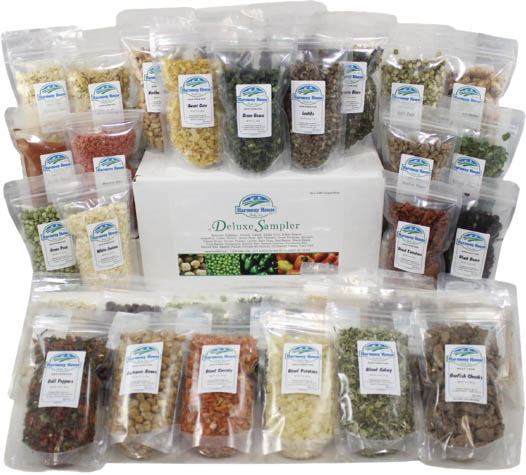 Cooking method: Pouch/pot
Cooking method: Pouch/pot
Average cook time: 10-15 minutes
Calories per ounce: N/A
What we like: Extensive selection of nutritious staples for DIY backcountry meals.
What we don't: Vegetarian and gluten-free options only.
Harmony House's website is reminiscent of the bulk foods aisle of your local grocery co-op, with a large assortment of dehydrated and freeze-dried offerings. Ambitious backcountry chefs can stock up on the staples—dried vegetables and beans, meat-flavored TVPs (short for textured vegetable protein), fruits and berries, soup blends, and more—and save a good deal of cash in the process. You can pre-pack your meals at home (Harmony House sells a few different sizes of just-add-water zip pouches) or bring the pantry to the field so you can improvise for each evening's meal.
Unlike most backcountry food brands, Harmony House does not offer pre-packaged entrées, limiting their appeal to seasoned camp chefs or those inclined to DIY. And because Harmony House is completely vegetarian and gluten-free, you won't find dehydrated meats or many simple carbohydrates, which are an easy way to tack on extra calories and protein in the field. Further, most hikers will simmer these supplemental ingredients in a pot along with instant rice or noodles (easily purchased at your local grocery store), resulting in additional cleanup compared to simple pouch meals. But if you're on trail for long stretches and looking for an affordable yet healthy alternative to pre-packaged dinners, Harmony House is a great place to start.
See Harmony House Foods
Best of the Rest
6. Firepot ($13 - $14)
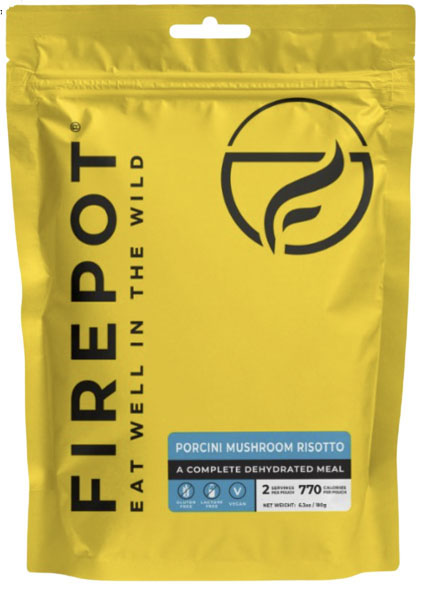 Cooking method: Pouch
Cooking method: Pouch
Average cook time: 15 minutes
Calories per ounce: 114
What we like: Well-sourced and delicious meals; more affordable than Heather's Choice.
What we don't: Supply can be low in the U.S.
Founded in the rural southwest of England, Firepot is fresh on the scene in the U.S., now being sold through the outdoor giant REI. We tested a number of their meals on a recent backpacking trip in Patagonia, and were very impressed with what the small startup has put together. Their entrees represent a positive shift in backcountry cuisine that we're all excited about: a focus on whole, natural ingredients and thoughtful flavors. Sourcing much of their ingredients from the rural area around their headquarters, Firepot's meals are some of the best we've tasted, and include a number of vegan and gluten-free options as well.
Firepot goes head-to-head with Heather's Choice as one of the best sourced and healthiest meals here. At 114 calories per ounce, it's not quite as power-packed as Heather's Choice, which might be a consideration for those particularly concerned about keeping pack weight low. On the other hand, you get a lot more calories per pouch—ours averaged about 770 calories per meal—which results in a significantly better value overall (especially if you're sharing your meal or like a healthy amount of food). Heather's Choice meals are currently a bit easier to find in the U.S., but we expect to see more and more Firepot hit the shelves over time. All in all, they're a great brand to have on your radar, and if you order online (a bit tricky from the States), you get the option of compostable packaging, too.
See Firepot Meals
7. Packit Gourmet ($12 - $13)
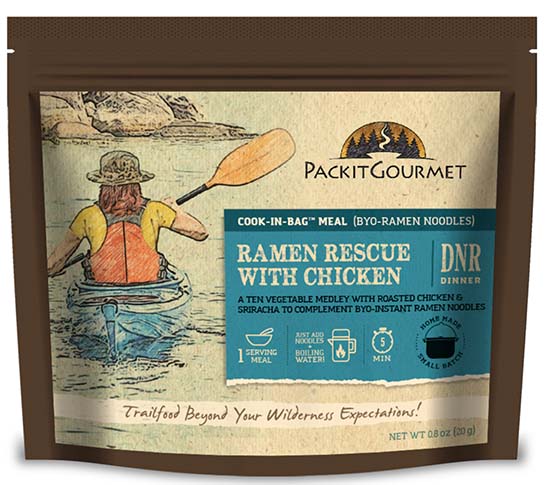 Cooking method: Pouch
Cooking method: Pouch
Average cook time: 10-15 minutes
Calories per ounce: 114
What we like: Tasty food with all the accoutrements.
What we don't: Short shelf life.
Packit Gourmet isn't quite a household name, but the small online marketplace boasts an impressively diverse lineup including prepackaged meals, bulk dried ingredients, individually packaged sauces, and even separate Cook-in-Bags for DIY dehydrated food. They offer more than 20 different tasty dinners (with a variety of options for special dietary needs) that are more flavorful than most of the competition. Packit sweats the details too: for example, their Austintacious Tortilla Soup comes with a packet of lime powder, dehydrated jack cheese, and tortilla chips. And although their meals are advertised as one serving, take a closer look at the label: some of them have more calories than two-serving meals from other brands.
Packit meals are packaged in recyclable materials, which is a nice bonus, and their updated pouches are low-profile and disappear easily into your pack. Unfortunately, the shelf life of most entrées is relatively short—only about a year and a half. Some also require you to pack your own ingredients: for example, the Big'un Burrito with Fajita Chicken is BYO tortilla. But at 114 calories per ounce, Packit meals have a very respectable caloric density for such unique, flavorful dishes, and we're certainly excited for dinner whenever we pull one out of our pack. And did we mention dessert?
See Packit Gourmet Meals
8.Mountain House Adventure Meals ($10 - $11)
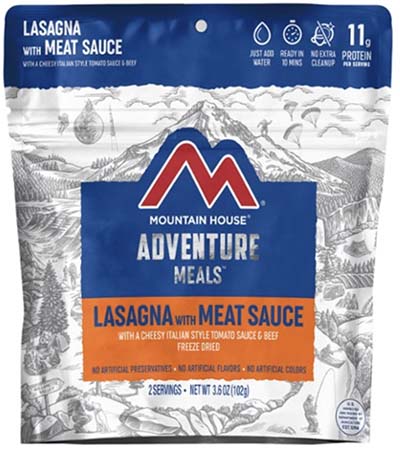 Cooking method: Pouch
Cooking method: Pouch
Average cook time: 9 minutes
Calories per ounce: 122
What we like: A classic value choice with decent taste and high caloric density.
What we don't: Lots of preservatives and sodium.
The Mountain House name is practically synonymous with freeze-dried food, and for good reason. They may not knock it out of the park in terms of taste, but these meals remain a reliable and lightweight standard for backcountry cuisine. Mountain House's home-cooked- style dinners—like Chicken & Dumplings and Chili Mac with Beef—cook up quickly (9 mins.) and are great for filling up after a long day on the trail. Importantly, you also get good bang for your buck with a price that undercuts similar two-serving options by around $4-5, as well as a high calorie-to-weight ratio. Plus, all Mountain House meals come with a 30-year Taste Guarantee, so you can buy now and eat much, much later.
Mountain House has been dishing up backcountry meals for over 50 years, but the competition has never been fiercer. Unlike options like Good To-Go and Heather's Choice above, you won't find all-natural or organic ingredients here, and those with special diets should look elsewhere. In addition, the pasta-heavy menu hasn't changed much in years, and each entrée is startlingly high in sodium (which can be a good thing, depending on your needs). And while Mountain House is a relatively affordable standby, Backpacker's Pantry wins out in terms of calories per dollar. In other words, we think there are a number of better options in 2022, but we certainly won't fault you for sticking with an old classic.
See Mountain House Meals
9. Trailtopia Adventure Food ($10 - $14)
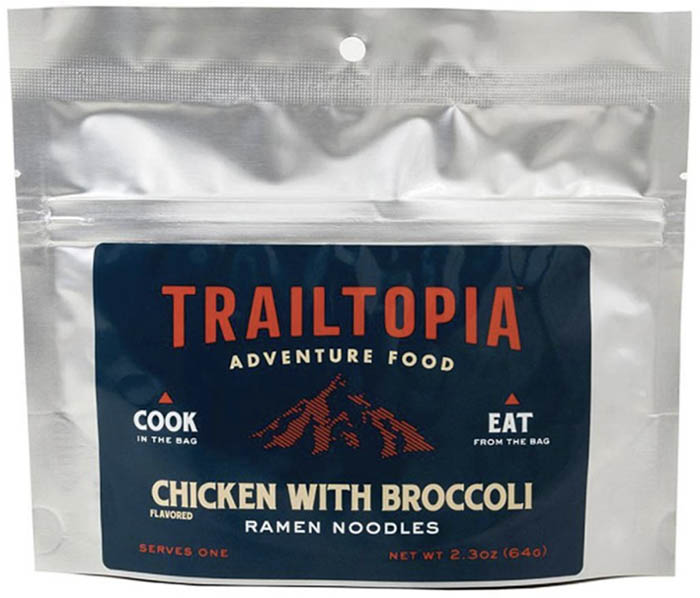 Cooking method: Pouch
Cooking method: Pouch
Average cook time: 8-15 minutes
Calories per ounce: 114
What we like: Quality ingredients and convenient packaging.
What we don't: Doesn't stand out in any other way.
Like entrées from brands such as Good To-Go and Heather's Choice, Trailtopia's ingredient lists are chock-full of all-natural foods with few chemicals or preservatives. Take their Cajun Smack Chicken & Rice, for example, which is similar to a meal you might have at home with long-grain rice, chicken, onion, broccoli, bell pepper, and spices. We're also big fans of their short and stout packaging (you won't have to go fishing with your spoon), and sample packs allow you to try out multiple meals at a discount before committing to full serving sizes. Finally, entrées are packaged to feed two (some single servings are available), and you can also pick up meat "side packs" to add extra protein.
There's no denying that Trailtopia's meals are healthy and taste good, which is great news at the end of a long day of hiking. But at only 49.4 calories per dollar, they're not a particularly great value among the competition, and you can pack in more calories at a lower weight with brands like Next Mile Meals and Peak Refuel. Additionally, the menu is pretty standard and uninspiring, and you'll have to dig a bit to find the gluten-free, vegetarian, and vegan options (you can't filter specifically, but these designations are listed directly on the product pages). But small gripes aside, we've enjoyed digging into many a Trailtopia meal, and they get our wholehearted recommendation for those looking for real trail food.
See Trailtopia Adventure Food Meals
10. Next Mile Meals ($14)
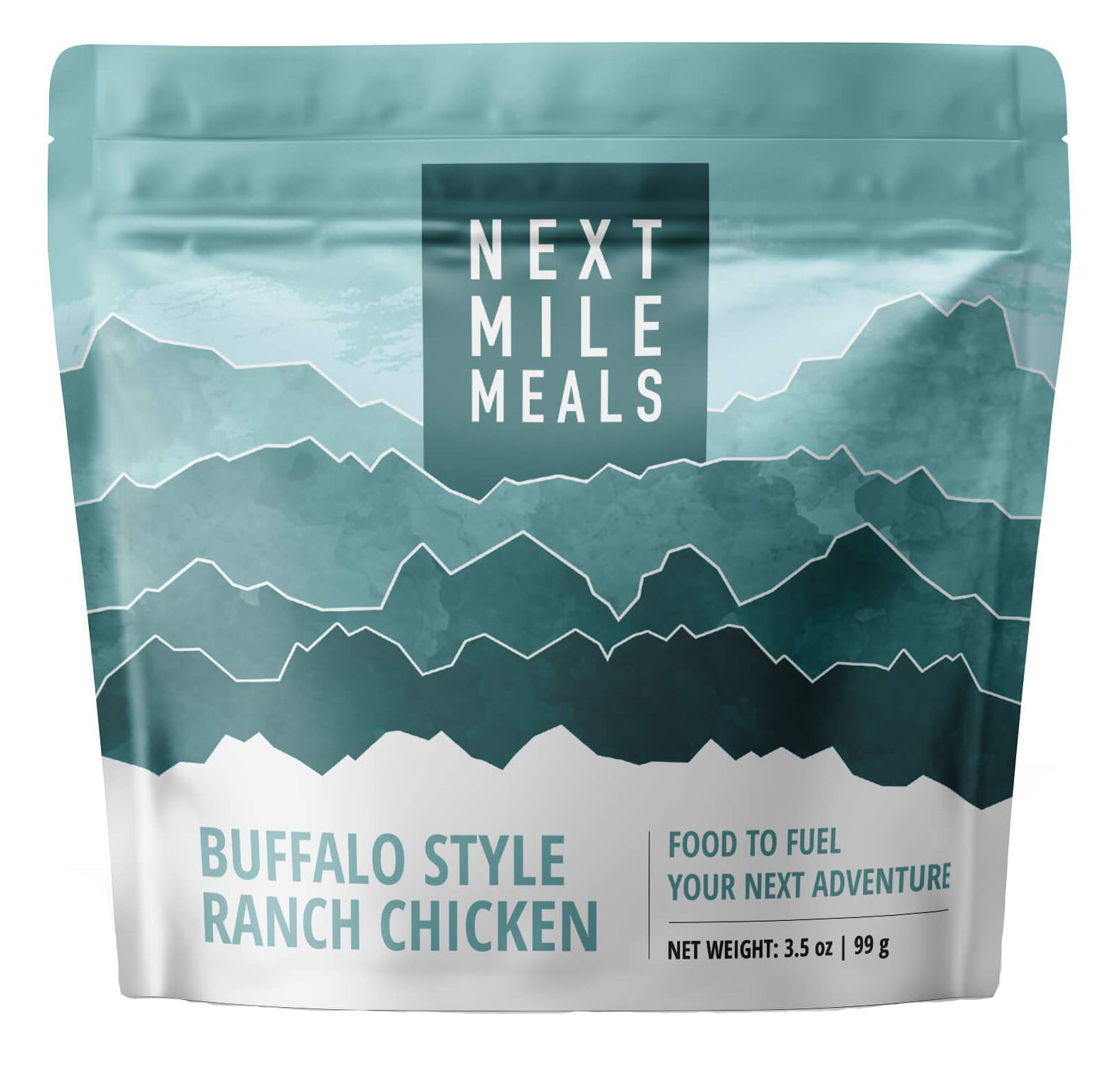 Cooking method: Pouch
Cooking method: Pouch
Average cook time: 7-10 minutes
Calories per ounce: 142
What we like: Incredibly nutrient-dense and generous serving sizes.
What we don't: Expensive and limited offerings.
Next Mile Meals is a small company that hasn't been around for long, but we took their meals on a recent trek in Chile's Parque Patagonia and came away very impressed with the flavors, ingredients, and quick cook time. Like Heather's Choice above, Next Mile Meals actually taste like real food, which shouldn't come as much of a surprise after looking at the ingredient labels. These ketogenic entrées cut the carbs and pack in calorie- and nutrient-dense foods like meat, veggies, and cheese. It all adds up to an impressive 142 calories per ounce on average, which is one of the best calories-per-weight specs here.
Our main gripe about Next Mile is the price: $14 only gets you a one-serving pouch, and at only 39 calories per dollar on average, they're far from a standout value (for reference, Backpacker's Pantry meals offer around twice the calories per dollar). You also don't get many entrée choices—seven at the time of publishing—but we expect more over time. Finally, Next Mile Meals are best within a year of purchase, and the included condiments have a short 180-day shelf life. But they're a great option in terms of caloric density, and it certainly doesn't hurt that Next Mile Meals are also all-natural and taste great.
See Next Mile Meals
11. Patagonia Provisions ($7)
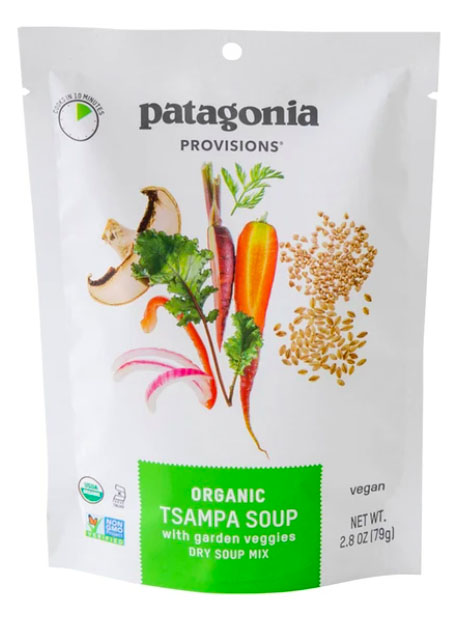 Cooking method: Pot
Cooking method: Pot
Average cook time: 10 minutes
Calories per ounce: 96
What we like: Responsibly sourced, manufactured, and distributed food.
What we don't: Small selection of side dishes and snacks only.
No, you're not seeing things. Patagonia—the legendary clothing company—is indeed making an appearance on our list of backcountry meals. Known for their environmental consciousness, the company's food branch—Patagonia Provisions—fits into the same mold. They responsibly source, manufacture, and distribute fruit and nut bars, buffalo jerky, salmon, hot cereals, dry soup and chili mix, ancient grains mix, and even beer. The food is designed and packaged for the backcountry, but to no surprise, it's all good enough to eat at home.
We hope to see Patagonia Provisions expand their lineup to include full dinners, but for now, their organic soups, chili, and grain mixes are great side dishes for times when you have a pot available. Soup is a perfect way to hydrate after a long day on the trail with warm, sodium-rich liquids, and many hikers will slurp one every evening alongside their dinner. And paired with salmon, their savory grains almost make a complete meal (but be forewarned, these meals do require more cleanup than usual). Plus, with an average of 96 calories per ounce, it's not super dense in calories. All gripes aside, many will find the Provisions offerings worth it for the class-leading flavor and nutrition.
See Patagonia Provisions Meals
12. Outdoor Herbivore ($8 - $16)
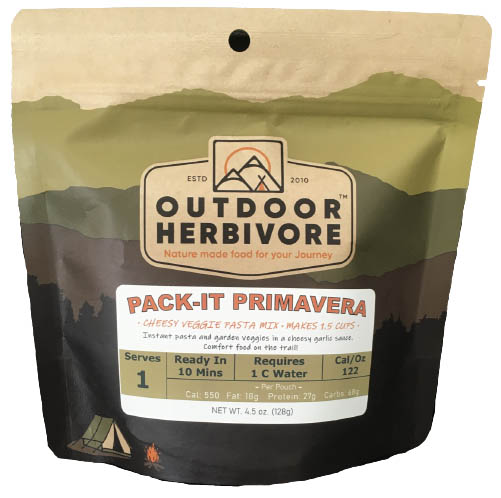 Cooking method: Pouch
Cooking method: Pouch
Average cook time: 10 minutes
Calories per ounce: 117
What we like: Healthy, all-natural meals that are low in sodium.
What we don't: Harmony House has a better selection of bulk ingredients.
Outdoor Herbivore might not have the brand recognition of names like Good To-Go or Mountain House, but they're nevertheless a great one-stop shop for backcountry meals and bulk ingredients. With an emphasis on more flavor with less sodium (a common additive in backcountry food), they offer a variety of breakfasts and entrées that feature a nice combination of all-natural ingredients and caloric density. Further, their meals are available in both single and double servings, which is a really convenient option to have. And there's no shortage of healthy choices to choose from: the Sacramento-based company prides itself on being 100 percent vegetarian, over 80 percent organic, and all-natural.
With a recent update to their packaging, the majority of Outdoor Herbivore's meals come in just-add-water pouches, eliminating the need to dirty a pot or bring an extra bowl. They also offer a number of meal combos, which make food planning and purchasing easy with sets for anything from weekend outings to 10-day epics. We took some of their meals along on a recent backpacking trip in Colorado's San Juan Mountains and were impressed with the quality of taste and ingredients, but were admittedly still hungry after the entrées in particular (many seem more like sides or salads than full meals). But you can always bump up to a double serving, and Outdoor Herbivore is also a great place for additional staples, including instant pasta, egg powder, dehydrated quinoa, and more.
See Outdoor Herbivore Meals
13. AlpineAire Foods ($7 - $14)
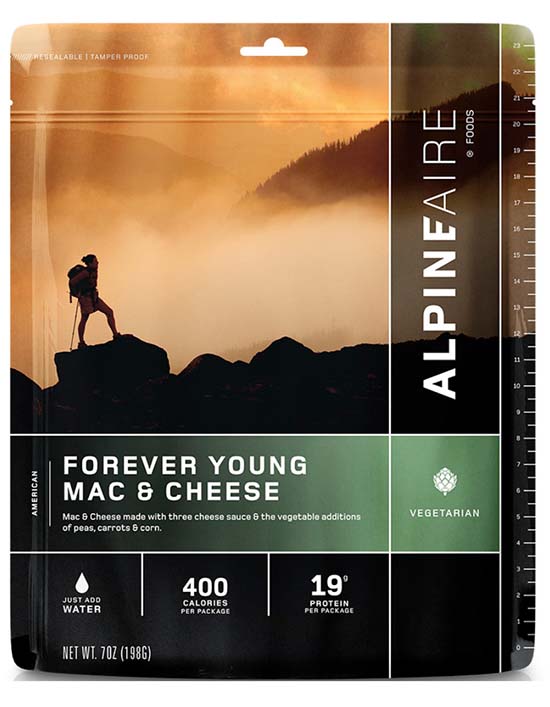 Cooking method: Pouch
Cooking method: Pouch
Average cook time: 10-12 minutes
Calories per ounce: 106
What we like: Low price and fun menu items.
What we don't: Tastes like standard backpacking fare.
We'll start by saying that AlpineAire meals sound delicious. With names like Al Pastor with Cilantro Lime Rice, Cheese Enchilada Ranchero, and Tuscan Grilled Chicken Alfredo, you practically feel like you're ordering from a restaurant. They also offer a plethora of special diet options: low-sodium, vegetarian, vegan, gluten-free, cholesterol-free, and all-natural. And their eye-catching packaging clearly displays information on ingredients, serving size, and nutrition. The pouches are flat and packable, and the main courses are as speedy to cook as Mountain House meals. With a relatively low price, AlpineAire seems like the whole package.
Unfortunately, the taste of AlpineAire meals just doesn't measure up. Perhaps their names and labeling create overly high expectations, or maybe mixing healthy ingredients with a short cook time stresses the flavors. Whatever it may be, we find that AlpineAire dinners are either noticeably bland or so over-spiced that they are hard to finish. If you find one you like, stick with it. Otherwise, the pouch meals above are both tastier and more calorically dense.
See AlpineAire Foods Meals
14. MaryJanesFarm Outpost ($6 - $14)
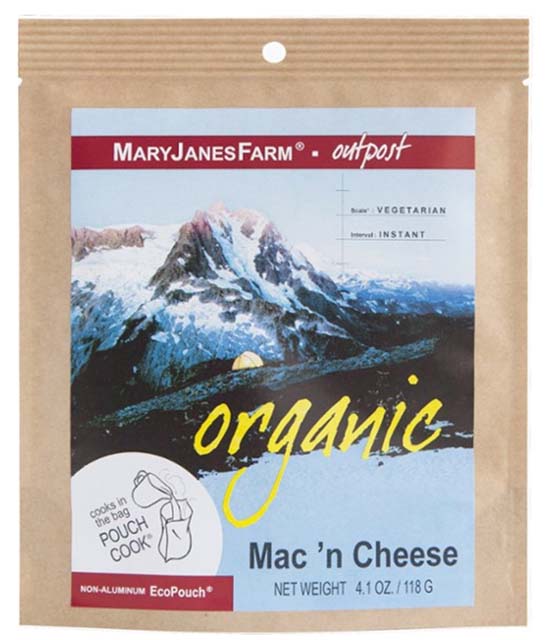 Cooking method: Pouch
Cooking method: Pouch
Average cook time: 10 minutes
Calories per ounce: 103
What we like: A whopping 40 dinners to choose from.
What we don't: The flavors leave much to be desired.
MaryJanesFarm offers a large assortment of all-natural, organic, mostly vegetarian meals at reasonable prices. Similar to many options here, you'll recognize all of the ingredients on their labels as real food. These meals (take your pick of around 40 dinners) cook up almost as quickly as Mountain House and are more nutritious and lower in sodium to boot. Another bonus is paper packaging that is recyclable or burnable. Plus, the MaryJanesFarm website offers bulk servings, perfect for decreasing packaging waste with large groups.
What are our complaints about MaryJanesFarm? It might be a matter of personal preference, but we found the dinners to be over-seasoned. Additionally, the eco-friendly packaging lacks a resealable closure for cooking your meal in the pouch, but squeezing the air out of the bag and folding the top underneath to cook is a fairly simple workaround. Finally, the advertised "single serving" is actually 1.5 servings, although this will be good news for hungry hikers.
See MaryJanesFarm Meals
15. Wild Zora Paleo Meals To Go ($13)
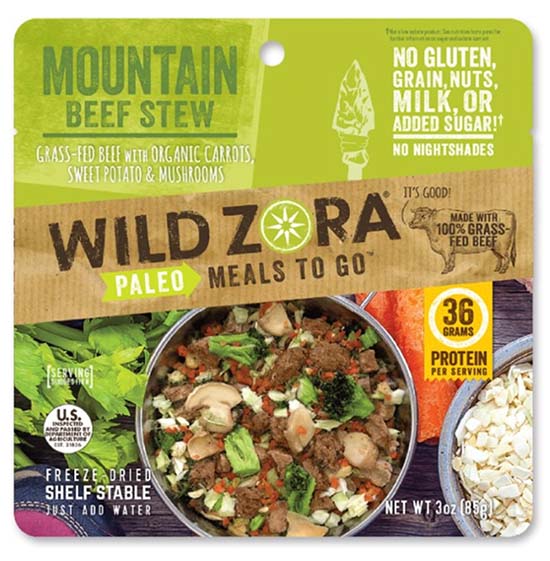 Cooking method: Pouch
Cooking method: Pouch
Average cook time: 10-12 minutes
Calories per ounce: 110
What we like: Incredibly nutrient dense.
What we don't: Steep price tag of $13 for a single serving.
In a world of noodle-heavy backcountry meals, Paleo Meals To Go's gluten-free and protein-rich offerings are refreshing, and you don't have to be paleo to enjoy them. The Mountain Beef Stew Pouch we tried had an impressive ingredient list: beef, vegetables, spices, and sea salt. The meat (free range, grass-fed, and 100% natural) especially stood out: it retained the taste and texture of real meat better than other freeze-dried meats we've tried.
One notable drawback to these tasty meals is shelf life, which according to the Wild Zora website, is only two years from the date of manufacture. That said, we ordered our meal in April and it came with an expiration date of November 11 of the same year. Paleo Meals To Go also come at a high price: $13 for one serving, to be exact. For that cost, you could have three servings of Backpacker's Pantry. But that price difference shows in the nutrition comparison: for one serving of Mountain House Beef Stew, you'll get 15% of your recommended daily Vitamin A, 15% of Vitamin C, and 8% of Iron. One serving of Paleo Meals To Go's Beef Stew Pouch is packed with 320%, 45%, and 90%, respectively. That's a huge selling point for those who are focused on getting more than just calories from their backcountry meals.
See Wild Zora Paleo Meals To Go
16. Nomad Nutrition ($12)
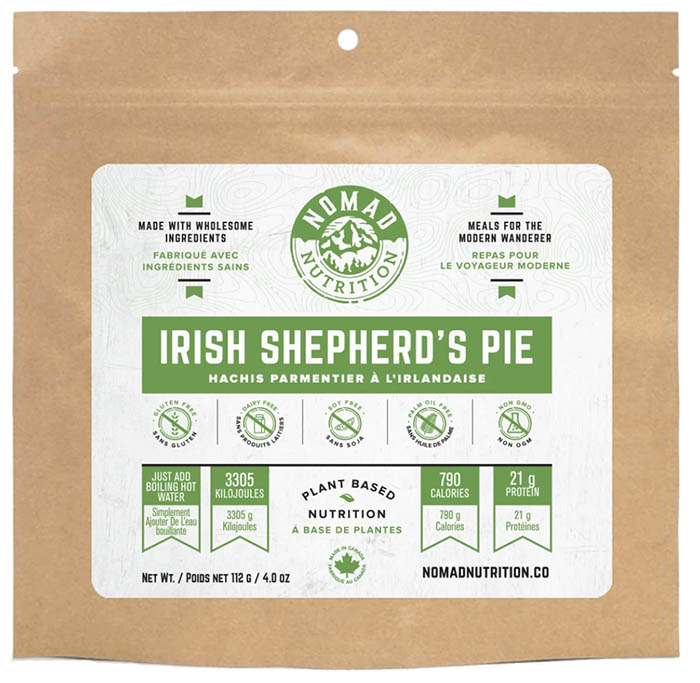 Cooking method: Pouch
Cooking method: Pouch
Average cook time: 8-12 minutes
Calories per ounce: 161
What we like: Unique dehydrating process and surprisingly calorie- and protein-packed.
What we don't: Limited selection and not the best value.
A small company founded by an adventurous foodie from British Columbia, Nomad Nutrition offers nutrient-dense meals with a strong emphasis on whole food ingredients. And despite being mostly plant-based and 100 percent gluten- and dairy-free, Nomad's entrées are startlingly calorie- and protein-packed, topping our list with an impressive 160.5 calories per ounce and 15 grams or more of protein per packet. And Nomad is doing things differently with their unique dehydrating process called REVdry, which cuts out the need for preservatives and keeps the ingredient list both natural and low in sodium (a rarity among the competition).
Compared to Peak Refuel above, Nomad Nutrition's meals have slightly more calories per ounce, and they manage to pull it off without a single noodle-based dish. But while two hungry hikers can get away with sharing a Peak Refuel pouch, Nomad's similarly priced meals will likely only feed one (they average about 600 calories per pouch), making them the pricier option by a sizable margin. For some it might be worth it: looking inside a Nomad Nutrition pouch is a clean-eater's dream, with a colorful rainbow of real food such as potatoes, broccoli, peppers, corn, peas, and more. All told, the company is off to a promising start, and we're excited to see where they're headed.
See Nomad Nutrition Meals
17. Mountain House Pro-Pak ($11)
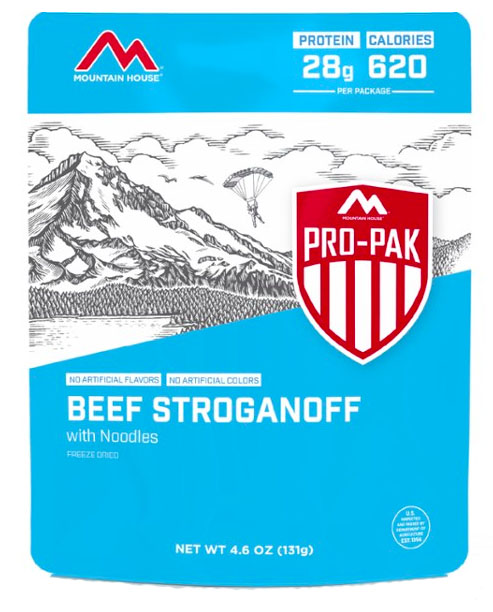 Cooking method: Pouch
Cooking method: Pouch
Average cook time: 9 minutes
Calories per ounce: 131
What we like: Calorie- and protein-rich single-serving meals.
What we don't: Expensive for one serving and not as tasty as other options above.
Mountain House is known for their standard lineup of Adventure Meals (above), but their Pro-Pak is a great option for intrepid backpackers, climbers, and other committed outdoor-goers. In years past, the Pro-Pak stood out with its vacuum-packed pouch, making it one of the most streamlined meals available (this design also prevented expansion at altitude). But the newest iteration shifted focus completely, forgoing the compressed size and instead placing a premium on protein, caloric density, and cold-weather performance. Reasonably priced at $11, each meal is offered in a single-serving package (520 - 650 calories), making Pro-Paks a nice option for solo adventurers.
That said, we don't think the changes were necessarily all good. Compared to Peak Refuel above, Pro-Pak meals fall short in calories for the weight (131/oz. vs. 155/oz. for Peak Refuel), are fairly basic in terms of taste and ingredients (there are no paleo, vegetarian, or gluten-free options), and are lower in protein. Finally, the updated Pro-Paks are only guaranteed for 5 years, although this shouldn't be much of an issue for most adventurers (a long shelf life matters more for emergency preparedness). In the end, if you like Mountain House but want a bit more nourishment for the weight, Pro-Paks are a fine choice. But for a few bucks more, Next Mile Meals or those from Heather's Choice are tastier and more nutritious.
See Mountain House Pro-Pak Meals
18. Omeals ($8-11)
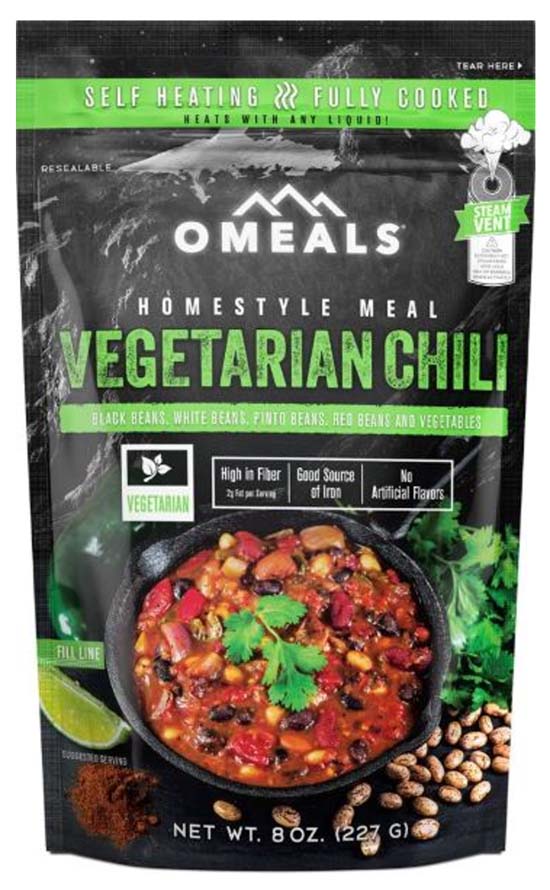 Cooking method: Pre-cooked
Cooking method: Pre-cooked
Average cook time: 5 minutes
Calories per ounce: 22
What we like: Tasty, convenient, and a fun cooking method.
What we don't: Way too heavy to be practical.
All of the meals above are made up of dry ingredients, but Omeals is a pre-cooked option that can be eaten straight from the package, hot or cold. It even comes with a heating element that is activated with 3-5 ounces of any kind of liquid (even sea water or coffee). You don't need a stove or running water to heat up a warm dinner, making convenience the forte of an Omeals meal. And because they're not dehydrated, Omeals taste a lot better than standard backpacking fare. Their flavor and texture are more along the lines of canned chili than rehydrated mush.
If they're tasty and convenient, then why are Omeals all the way down at the bottom of our list? Take a look at the calories per ounce spec above: the average Omeals dinner weighs 10.4 ounces (including the heating element) and is only 230 calories. For the weight of one Omeals package, you could bring five Mountain House meals, which would add up to over 1,300 calories. Furthermore, the heater becomes bulky when activated, so your load won't decrease too much after dinnertime. You won't find us bringing Omeals into the backcountry very often, but for certain applications—going without a stove, emergency food in the car, canoeing, or the novelty of watching a flameless heater at work—they can be a tasty choice.
See Omeals Meals
19. MRE Complete Meal ($25)
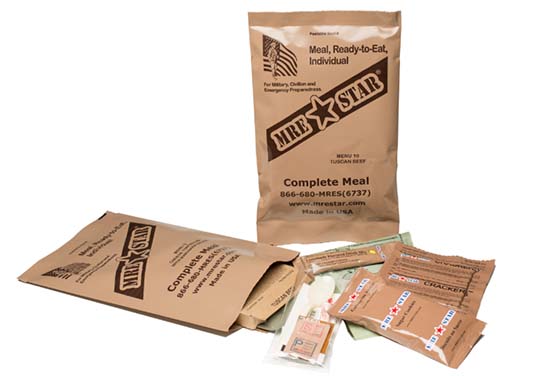 Cooking method: Pre-cooked
Cooking method: Pre-cooked
Average cook time: 10-15 minutes
Calories per ounce: 70
What we like: Cheap calories and everything you need in one package.
What we don't: Not much emphasis on taste or ingredients.
If you're military personnel, a firefighter, or a search and rescue volunteer, just hearing the acronym MRE—meals ready to eat—might send shivers down your spine. It's likely you've had your fill. Similar to Omeals, MREs are pre-cooked and can be eaten hot or cold, though they too come with a flameless heater. Each complete meal comes with everything you'll need: an entrée, side dish, dessert, crackers/bread, spread (cheese, jelly, etc.), powdered beverage mix, utensils, a beverage mixing bag, chewing gum, napkin, coffee powder, and various seasonings.
If you're looking for flavorful or all-natural ingredients, look elsewhere. MREs are made for function: they can withstand parachute drops from over 1,000 feet and have a shelf life of 3 years in 80-degree heat. These meals are heavier than most because they're pre-cooked, but unlike Omeals, they still pack in an impressive amount of calories. Take note: the supply of MREs seems suspect, so take care when purchasing. Civilian MREs are now made by many manufacturers, and websites such as Be Prepared allow you to pick your flavors and ensure that the meals you purchase aren't past their expiration date.
See MRE Complete Meals
Backpacking Meals Comparison Table
| Food | Price | Cal/$* | Method | Time | Cal/Oz* | Special Diet Options |
|---|---|---|---|---|---|---|
| Good To-Go | $8-15 | 53.7 | Pouch | 15-20 min. | 112 | GF, vegan, vegetarian |
| Backpacker's Pantry | $7-13 | 69.9 | Pouch | 15-20 min. | 113 | GF |
| Heather's Choice | $13-16 | 34.4 | Pouch | 20 min. | 130 | GF |
| Peak Refuel | $13 | 60.5 | Pouch | 10 min. | 155 | Vegan, vegetarian |
| Harmony House Foods | N/A | N/A | Pouch/pot | 10-15 min. | N/A | GF, vegan, vegetarian |
| Firepot | $13-14 | 59.2 | Pouch | 15 min. | 114 | GF, vegan |
| Packit Gourmet | $12-13 | 34.7 | Pouch | 10-15 min. | 114 | N/A |
| Mountain House | $10-11 | 54.6 | Pouch | 9 min. | 122 | GF, vegetarian |
| Trailtopia Adventure Food | $10-14 | 49.4 | Pouch | 8-15 min. | 114 | GF, vegan, vegetarian |
| Next Mile Meals | $14 | 39 | Pouch | 7-10 min. | 142 | GF |
| Patagonia Provisions | $7 | 68 | Pot | 10 min. | 96 | GF, vegan |
| Outdoor Herbivore | $8-16 | 68.6 | Pouch | 10 min. | 117 | GF, vegan, vegetarian |
| AlpineAire Foods | $7-14 | 65.8 | Pouch | 10-12 min. | 106 | GF, vegan, vegetarian |
| MaryJanesFarm | $6-14 | 57.9 | Pouch | 10 min. | 103 | GF, vegan, vegetarian |
| Wild Zora Paleo Meals | $13 | 26.2 | Pouch | 10-12 min. | 110 | GF |
| Nomad Nutrition | $12 | 53.5 | Pouch | 8-12 min. | 161 | GF, vegan |
| Mountain House Pro-Pak | $11 | 55.9 | Pouch | 9 min. | 131 | N/A |
| Omeals | $8-11 | 29.6 | Pre-cooked | 5 min. | 22 | Vegetarian |
| MRE Complete Meal | $25 | 62.5 | Pre-cooked | 10-15 min. | 70 | Vegetarian |
*These numbers represent the averages of weight, price, and calories per serving for the top five meals from each brand (when available).
Backpacking Meals Buying Advice
- About Our Rankings
- Cooking Method: Pouch, Pot, and Pre-Cooked
- Cooking Time
- Calories and Serving Size
- Weight (Calories per Ounce)
- Ingredients and Dietary Restrictions
- All-Natural Options
- Special Diets
- Sodium
- Dehydrated vs. Freeze-Dried
- Breakfast and Coffee
- Bulk Ingredients
- DIY Dehydrated Meals
- Stoves, Fuel, and Cooking Supplies
- Shelf Life and Emergency Preparedness
About Our Rankings
Backpacking food is a difficult gear item to rank because taste is highly individualized. Some of us love high-sodium meals in the backcountry, while others crave all-natural ingredients. Some prioritize flavor and nutrition, while others look for calorie-dense meals that pack down small. Our rankings above take all of these factors into consideration: price, weight, flavor, ingredients, packaging, variety of menu, and more. But because we're all looking for something different to eat, you simply might not agree with our numbering. That's okay. Using the chart above, you can hone in on what matters most to you and compare the specs for all of the meals we included.
.jpg)
Cooking Method: Pouch, Pot, and Pre-Cooked
One way we've categorized the meals in this article is by cooking method: pouch, pot, or pre-cooked meal. In 2022, many backcountry travelers opt for "pouch" meals like Good To-Go due to their ease of preparation and cleanup. You simply add boiling water to the pouch and let it sit for the specified amount of time, and no bowl or pot is required (nor is cleaning said bowl or pot after your meal). Notably, the lack of cleanup also reduces impact on fragile wilderness environments. On the other hand, "pot" meals require that you pour the dried contents into a pot, add water, and most often heat the meal over a flame. Sometimes instructions will require that you simmer the meal for up to 10 minutes (requiring a backpacking stove with good flame control). Of course, when the meal is finished, you have to clean the pot and pack it away for your next day on the trail.
.jpg)
Pre-cooked meals use a preservation process similar to canning, resulting in a shelf-stable meal that can be eaten with or without warming. The two pre-cooked meals on our list, Omeals and MRE Complete Meals, come with a small flameless heater, so you can leave your stove and pot at home. The heaters only need a small bit of water to activate, making these meals a huge plus when traveling in dry environments like Utah. But before you get too excited about going sans stove, check the calories per ounce column of the comparison chart. Pre-cooked meals are significantly heavier than the dehydrated or freeze-dried competition and aren't viable for most weight-conscious backcountry travelers. That said, depending on factors including the length of your trip, they could be lighter than the combination of dehydrated meals and a stove with fuel.
.jpg)
Cooking Time
Depending on the cooking method, the meals in this article take anywhere from 5 to 20 minutes to cook. For pouch meals such as those from Heather's Choice, you simply let the food sit in hot water for 15-20 minutes—no need to tend to it. Pitch the tent, collect more water, sit down and work on a crossword with your hiking partner—20 minutes will fly by. We personally don't mind this waiting time and find the distinction between 8 and 20 minutes almost inconsequential (although this doesn't mean that we don't dig in a little early and eat crunchy noodles on the rare occasion). On the other hand, pot meals like those from Patagonia Provisions require that you stir the meal occasionally as it simmers, meaning you'll need to be beside your backpacking stove for the duration of the cook time.
.jpg)
Calories and Serving Size
We're not here to provide an equation for calories burned based on mileage, elevation gain, pack weight, altitude, body weight, and metabolism, or give our opinion on whether or not a backpacking trip is a prime time to start a diet. We'll leave that to the experts and to your own personal discretion. But we will say if you want to stay strong and energetic during outdoor activities, you'll generally need to eat more than you would on a normal day at home. It's quite simple: for every calorie out, you want to put at least one in. With that in mind, calories are your friends in the backcountry and the numbering on nutritional labels deserves your attention.
When you find the calorie number on the back of your food pouch, take note that it denotes the number of calories in a single serving. This is not necessarily the number of calories for the whole pouch: some are single serving, others are double, and some are even made to serve four people. And keep in mind that companies vary significantly on serving size. A standard MRE, for example, contains 1,055 calories per serving, while an average Mountain House meal serving contains 264 calories. Speaking from personal experience, on a serious backpacking trip we find that we need a double serving from most brands to satiate our hunger at dinnertime. For this reason, we recommend that you pay more attention to the calorie count than the serving size, and don't be shy about eating far more than one serving. Not often does food go to waste in the backcountry…
.jpg)
Weight (Calories per Ounce)
Whether you're a thru-hiker who saws off half your toothbrush and tears completed pages out of your book, or a weekend warrior who enjoys creature comforts on the trail, all backcountry travelers share some level of concern about weight. Because food is such a large portion of your load, the goal is to maximize taste and calories for the least number of ounces. For this, our "calories per ounce" spec can be your guide.
.jpg)
To come up with this number, we divided the number of calories by the weight of the packaged meal. For example, Packit Gourmet meals average 558 calories per 4.88 ounce serving: divide 558 by 4.88 and you get 114, the calories per ounce. You'll want to aim for around 100 calories per ounce, and the larger this number, the better. To illustrate, an average Omeals meal contains only 27 calories per ounce, whereas Peak Refuel meals contain 155 calories per ounce. So, if you're hoping to consume a 700-calorie dinner, Peak Refuel will weigh 4.5 ounces, and your Omeals dinner a whopping 26 ounces. Add it all up over a week-long trip and with Omeals, you're either going on a death march with a very heavy backpack or a hunger march with an empty stomach.
Ingredients and Dietary Restrictions
All-Natural Options
Much to the delight of the health-conscious, there are a growing number of all-natural (meaning real food: no artificial flavors, additives, or preservatives) backcountry meal options. In fact, the majority of brands here—including Good To-Go, Patagonia Provisions, Outdoor Herbivore, Heather's Choice, Next Mile Meals, and Firepot—pride themselves on using only natural ingredients. Others, such as AlpineAire, have many all-natural options and strive to use only real food ingredients whenever possible.
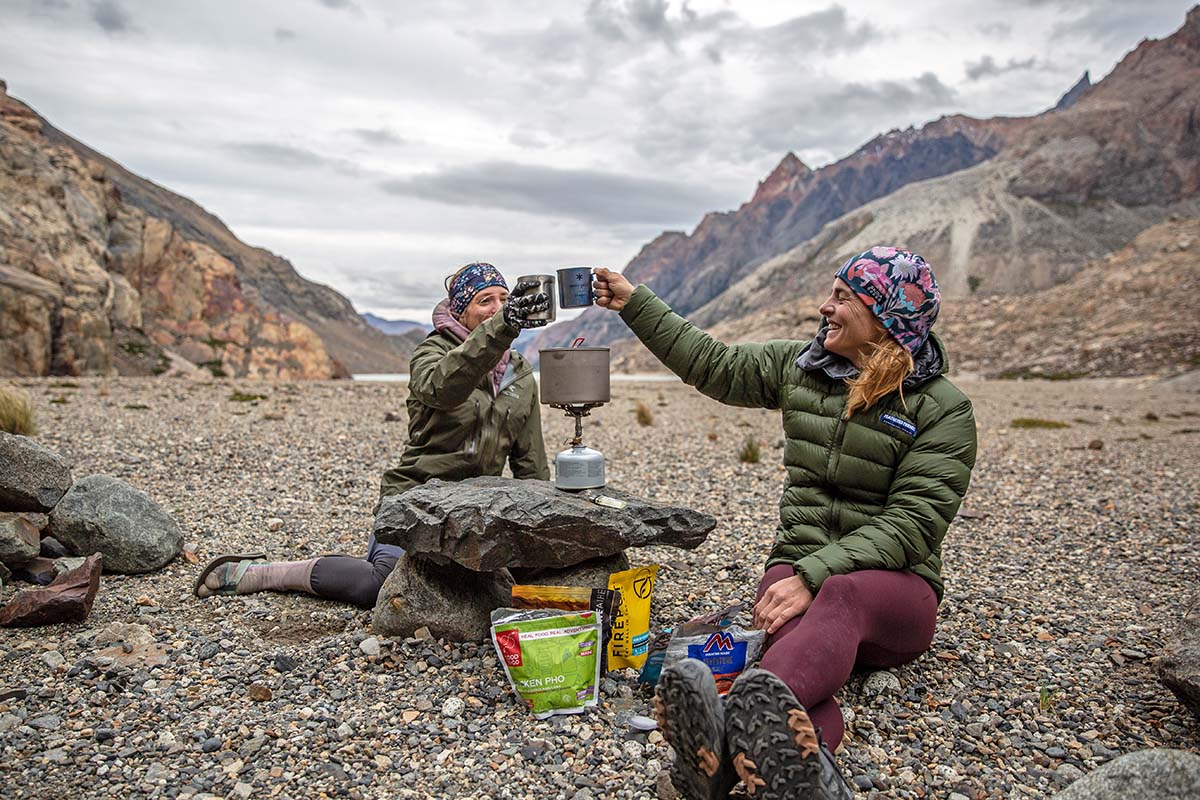
Preservatives are one of the most common unnatural offenders in backcountry meals, added to increase the shelf life and guard food from being spoiled by microorganisms such as mold, bacteria, and yeast. Although some preservatives are natural (salt, garlic, spices), many are manufactured chemicals. Mountain House's 30-year guarantee is an extreme example, requiring a good deal of unnatural ingredients and a heckuva lot of sodium for such a long shelf life. On the other hand, if you can read an ingredient label and know where to find each entry in the grocery store, chances are they're natural.
Special Diets
Most backcountry food brands have adapted their menus to accommodate the growing vegan, vegetarian, paleo, ketogenic, gluten-free, dairy-free, soy-free (etc., etc.) markets. Generally, it shouldn't be difficult to find meals that suit your dietary needs. Good To-Go pouches, for example, are fully gluten-free. Outdoor Herbivore only sells vegetarian and vegan cuisine. MaryJanesFarm meals are organic, Heather's Choice only uses ethically sourced meats, and Next Mile Meals appeals to the ketogenic crowd. Finally, AlpineAire offers a filter feature on their website that allows users to find meals with specific ingredients or special diet options. To help highlight the possibilities, we've included the "special diets" spec in our table above.
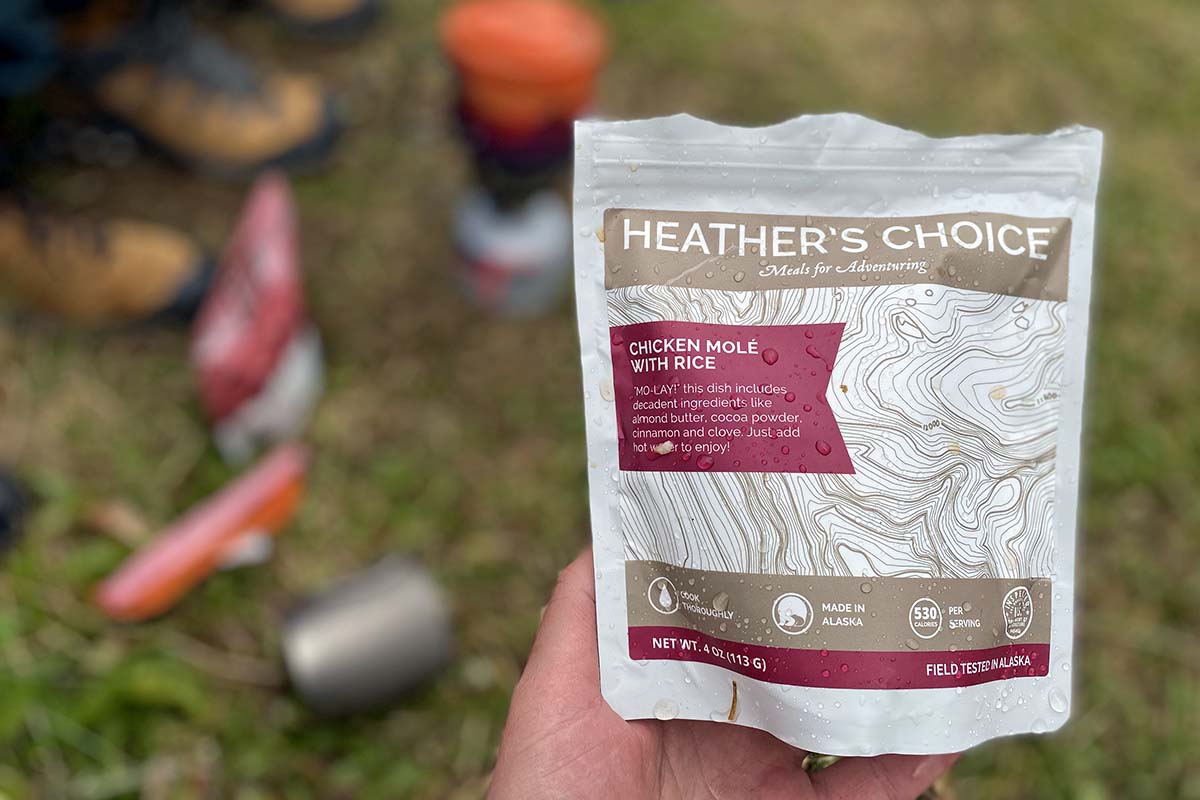
Sodium
The American Heart Association recommends that adults limit their sodium intake to 2,300 mg per day, and ideally not exceeding 1,500 mg. However, most healthy and active individuals who spend much of the day sweating in the hot sun will need—and thus crave—high-sodium foods to replenish what is lost. With an average of 400 to 800 mg of sodium per serving (and remember, you're probably eating more than one serving), it's no secret that most backcountry meals are high in sodium. If you're looking to keep your sodium intake down, pay special attention to the nutritional facts (we see a great deal of variation from meal to meal). Additionally, meals from Outdoor Herbivore, Good To-Go, and Nomad Nutrition tend to be lower in sodium than most.
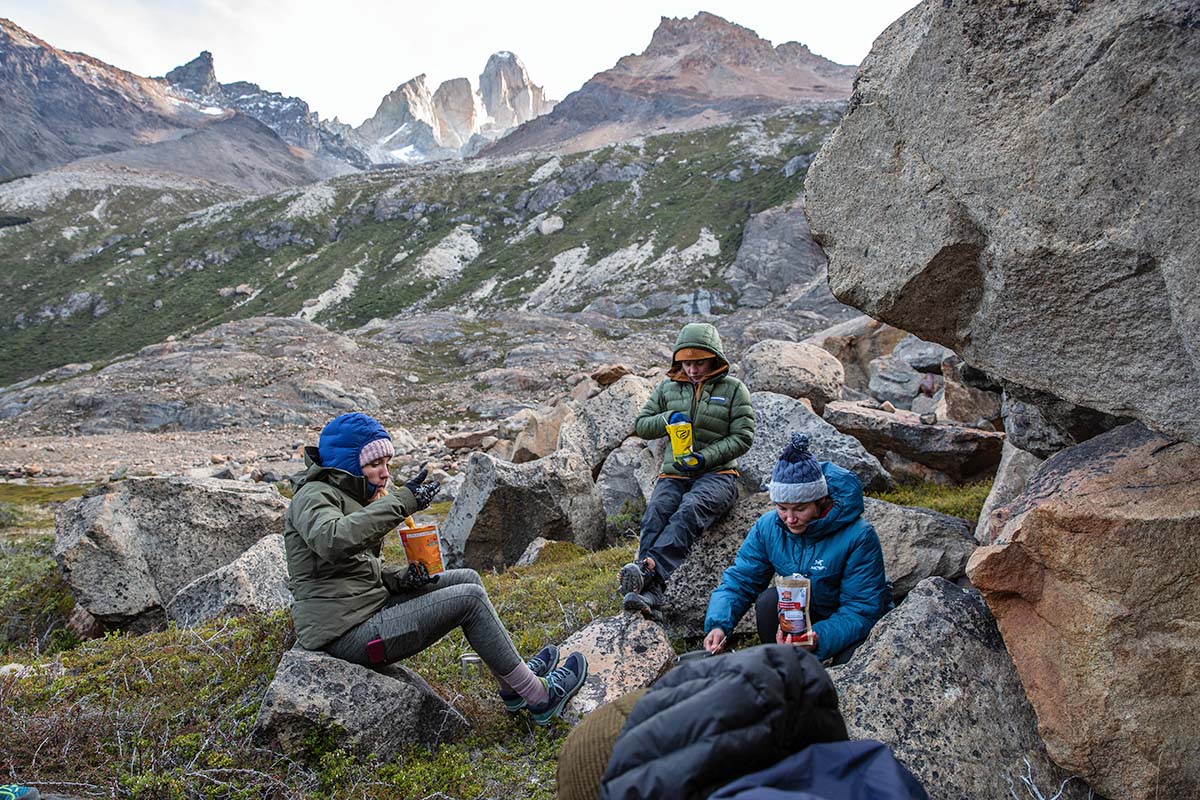
Dehydrated vs. Freeze-Dried
Dehydrating and freeze-drying are two distinct methods of food preservation. In the freeze-drying process, food is placed in below-freezing temperatures and gradually warmed, moving water in the food from a solid to gaseous state. The dehydration process, on the other hand, exposes food to hot and dry air over several hours (smoking and sun-drying are also methods of dehydrating). In the end, the freeze-drying process removes 98-99 percent of moisture from food, while dehydrating removes 95 percent. Both processes result in dried food that needs to be soaked in water to regain its size, texture, and edibility, but with noticeably different characteristics.
Due to its lower water content, freeze-dried food is lighter and has a longer shelf life than dehydrated food. Surprisingly, it also rehydrates almost twice as quickly—freeze-dried Mountain House meals cook in 9 minutes vs. the 20 minutes required for dehydrated Good To-Go meals. On the other hand, dehydrated ingredients shrink more (think plum to prune), meaning they'll take up less room in your pack. They're also known to keep their original texture better than freeze-dried ingredients. In terms of taste, the two methods go head to head.
.jpg)
While some brands (like Good To-Go and Mountain House) use either exclusively dehydrated or freeze-dried ingredients, most use both. Manufacturers use discretion when choosing which process works best for each ingredient, weighing the pros and cons of flavor, size, and price. In short, the freeze-dried versus dehydrated debate matters little to the everyday consumer. The companies do the legwork to find the best way to dry food, so we can sit back after a long day on the trail and enjoy the outcome.
Breakfast and Coffee
To complete your meal kit, most backpackers will want to add breakfast and coffee (and snacks) to their shopping list as well. For many of us, breakfast is a lighter, quicker, and simpler meal than dinner, and oftentimes bulk oatmeal or a bar with some dried fruit will suffice. But for those who prefer a more substantial or elaborate start to their day, there are myriad options to choose from. Most brands featured above offer a lineup of breakfasts too, ranging from savory options like the Mountain House Breakfast Skillet to sweet treats like Backpacker's Pantry Granola with Bananas, Almonds and Milk. Packaged backcountry breakfasts usually land in the $7-9 range and are available in one- and two-serving options.
.jpg)
If you're anything like us, breakfast just isn't complete without a hot cup of coffee. You have a lot of options when it comes to a backcountry brew, ranging from lightweight and portable pour-over setups to disposable drip coffee kits from brands like Kuju. The most lightweight solution is instant coffee, which we've found to be perfectly sufficient for our morning cup of joe. A number of options are available, from Trader Joe's to the ubiquitous Starbucks Via. Our personal favorite is Alpine Start, a small start-up out of Boulder that specializes in making fantastic coffee for the trail. Alpine Start can be made with hot or cold water and is good enough that we've even been caught drinking it at home a time or two.
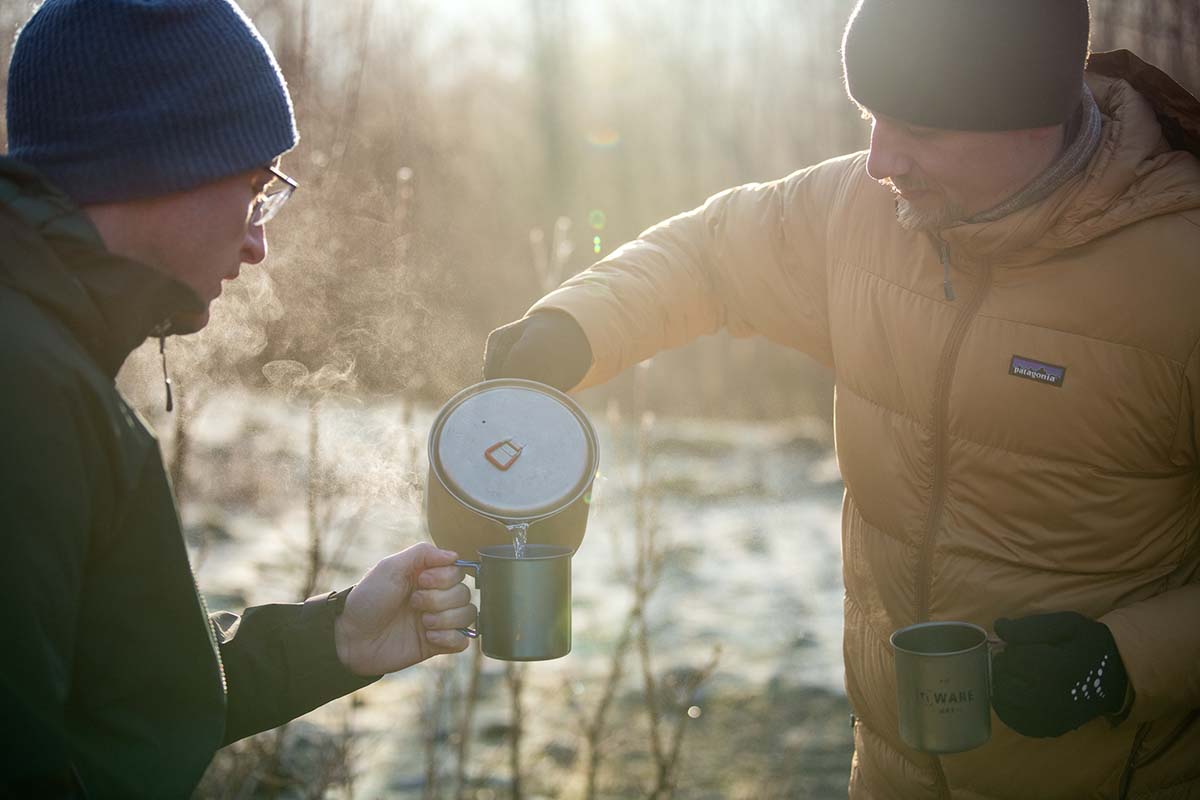
Bulk Ingredients
The pouch meals predominantly featured in this article might be your most convenient option for backcountry dining, but they aren't the only way to eat dehydrated or freeze-dried ingredients. Maybe you're pinching your pennies, cooking for the masses, or just enjoy channeling your inner chef in the wilderness. You can find bulk dehydrated and freeze-dried ingredients from a number of online vendors, including Harmony House Foods, HQ Organics, and Packit Gourmet. And recipes aren't hard to come by: with a simple Google search you can find tasty meal ideas like this Beef and Barley Stew.
DIY Dehydrated Meals
You're paying a pretty penny for convenience when you opt for the prepackaged meals above. A one-stop shop at your local gear store (or even online) can save you hours in meal planning for your next backcountry trip. That said, if you're inclined to DIY, you can save yourself a great deal of money by dehydrating your own meals. You can even do so in your oven, although most will find an actual food dehydrator works better. You'll usually want to cook your ingredients before dehydrating (a raw onion, dehydrated and then rehydrated, is still a raw onion). Many online guides provide the temperature and time specifications for different types of food. And take note: if you're dehydrating food and planning to store it for months or years, make sure that it's properly dehydrated and fully sealed.
.jpg)
Other Meal Options
The prepackaged meals and dehydrated ingredients we've mentioned above are the most convenient and lightest way to eat in the backcountry. That said, there really are no rules here and plenty of "real" options. Macaroni and cheese, couscous and canned chicken, a frozen burrito bought the morning of, Tasty Bites, even fresh vegetables: the sky is the limit. For some, food preparation (rather than simply pouring water into a pouch and waiting 10 minutes) can even be a fun way to relax at the end of the day. There's no denying that dehydrated meals are the easiest, but don't let this article lull you into thinking that they are the only way to go. Be creative and have fun out there.
.jpg)
On the other end of the spectrum, relatively new enterprises like RightOn Trek take the legwork out of food planning and packing with their made-to-order meal kits. All you have to do is specify the size of your group, number of days, and a bit about your food preferences, and they'll prepare your breakfast, lunch, dinner, and snacks for the entire trip. Essentially, it's like a Blue Apron for backpacking food. For first-timers who find themselves intimidated by the process of packing food for the backcountry, this might be a really good way to go.
Stoves, Fuel, and Cooking Supplies
Many of the meals in this article rehydrate in their pouch, making them popular options because they only require adding boiling water. For these meals, we recommend bringing an all-in-one stove system such as the Jetboil Flash. It's compact, boils water quickly, and is reasonably priced. For "pot" meals, you'll probably want a more traditional stove with a simmering function, like the MSR PocketRocket 2 or Dragonfly. For more information including our top picks, check out our article on the best backpacking stoves. If you want to leave the stove behind, consider bringing pre-cooked dinners or meals that can be hydrated with cold water.
.jpg)
The amount of fuel you'll need on your next backpacking adventure depends largely on whether you're eating "pouch" or "pot" meals. For pouch meals, you simply boil the water, turn off the stove, and pour the water into the pouch. For pot meals, on the other hand, you might need to boil or simmer the food for up to 10 minutes. If you're out for a week, this cook time can certainly add up to a lot more fuel. Keep in mind that altitude, temperature, and wind are also factors in how much fuel you consume.
If you're eating only pouch or pre-cooked meals, chances are you won't need to pack a pot. For meals that require cooking over a flame, take your pick from a wide assortment of pots and pans, from ultra-lightweight titanium to more durable stainless steel or aluminum. When cooking for more than one, we recommend bringing a lightweight bowl or mug/bowl combo along. If you're traveling solo, you can save weight and just eat straight from the pot. Finally, keep in mind you might want a second pot or kettle to use exclusively for boiling water for hot drinks.

Shelf Life and Emergency Preparedness
A meal's shelf life denotes the amount of time that it retains its flavor, nutrition, and edibility. Looking at the brands above, the shelf lives vary from 1 to 30 years, depending on the preservation method (dehydration, freeze-drying, or pre-cooking) and type/amount of preservatives used. This information is easy to find on the packaging or manufacturer website. To guarantee their shelf life, backcountry meals should be stored fully sealed in a cool and dry environment (no refrigeration needed).
Most backcountry enthusiasts are buying for their next adventure, meaning that shelf life shouldn't be a concern for most. But backpacking food, as it turns out, is also ideal for emergency preparedness—it takes up less space on your shelves than canned goods (the benefit of that calorie-to-weight ratio), lasts for a long time, and is easy to prepare. For stocking up in case of an emergency (or if you're buying in bulk for trips well into the future), the shelf life is a specification worth considering. And if food storage is your main intent, we do recommend buying in bulk. Companies like Mountain House offer their meals in cans and even buckets, which will take up significantly less space and save on both packaging and money.
Back to Our Top Backpacking Meals Picks Back to Our Backpacking Meals Comparison Table
Source: https://www.switchbacktravel.com/best-backpacking-meals
0 Response to "Wild Zora Mountain Beef Stew Shelf Life"
Post a Comment